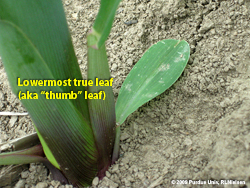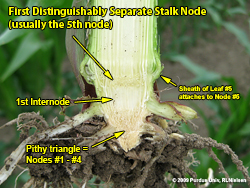Crop Staging + Foliar Feeding = Higher Yield Potential
While healthy plants start from the roots up, now’s the time in the growing season when foliar feeding is key. The foliar uptake of nutrients is much faster than root uptake, meaning foliar feeding is the most efficient choice to feed your crop and keep plants healthy.
In order for foliar feeding to be successful, you have to be able to stage the crop correctly. Staging is also vital for Not only is staging important for foliar feeding but for applying herbicides at the correct stage to get the best efficacy.
When staging corn, I like to use the “Leaf Collar Method (or LCM).” The LCM stages corn based on leaf collars. Using the LCM, if the leaf doesn’t have a collar, it isn’t staged as a true leaf.
The first leaf that emerges from a corn seedling has a rounded tip and is called the plumule. The first leaf is the only leaf that has a rounded tip. Subsequent leaves have a pointed tip. Once you find the plumule, start counting the collars of the other leaves up the plant.

A collar is a yellowish ring located just under the leaf where it attaches to the stalk. Once the plant has a collar, it is called a “V” stage, or vegetative. V1 is the rounded tip leaf or the plumule. V2 is the second leaf with a collar, and so on up the plant.
As the corn plant continues to grow, around V6 or so, the plumule will dry up, and you won’t be able to use the plumule as your beginning leaf for staging. When that happens, dig up a plant, and slice the stalk down the middle (be careful, as the stalk is sharp!) making sure to keep the leaves intact. Find the lower brownish part at the base of the stalk (around the soil line) and then find the white internode just above that. The white internode is typically where the fifth leaf developed.

Assuming this, you can count up the stalk by finding the leaf collars and be able to stage the older plant. The plant will continue to develop leaves and collars until the tassel emerges, and pollination takes place. (see table 1 for more details on corn stages.)
Staging soybeans
Soybeans are easier to stage than corn. The first leaves that appear on a soybean plant are cotyledons. The cotyledons are thicker and have a waxy feel to them, compared to normal soybeans leaves.
When the cotyledons emerge, this is called VE. The plant continues to grow and unifoliate leaves will form. When they unroll, that’s called VC. The remaining leaves will be trifoliates. The first trifoliate will be V1, the second trifoliate is V2 and so on as the plant progresses.
Around June 21, the longest day of the year, the plant senses that the days are becoming shorter, so it forms its first flower. This is the beginning of reproduction and is called R1. (see table 2 for more details on soybean stages.)
Tips for foliar feeding corn
Staging crops correctly is a key to successful foliar feeding, which can be 20 times more efficient than root feeding. Science proved the power of foliar feeding roughly 70 years ago.
Dr. Silvan Wittner and H.B. Tukey of Michigan State University, in conjunction with the Atomic Energy Commission, conducted extensive research on foliar feeding using radioactive nutrient (phosphate and potash) solutions during the 1950’s. They proved that foliar feeding was eight to 20 times more efficient than root feeding. They also found that 95% of foliar fertilizer applied to the leaf is used by the plant, in comparison to 10% of soil applied nutrients. Foliar feeding essentially supplied a nine-fold increase in efficiency
Foliar feeding can help you achieve more kernels around the ear
For corn, applying a foliar at V5, before V6 when the kernels around the ear are determined, is one of the critical times in a corn plant’s life. Remember that rows of kernels are always even, so if you add rows of kernels, you’ll be adding two rows at a time. If you add two rows going from 16 to 18 at 32,000 ears/A, you increase yield by 25 bu/A.
Foliar feeding can also add more kernel length. The kernels per row of the ear are determined beginning at V8 and finishing around V12. Let’s stick with the example of 32,000 ears and 18 kernels around. If you have 35 kernels in length and add 15 more, you increase yield by 96 bu/A.
Tips for foliar feeding soybeans
For soybeans, the critical growth stages occur during reproduction. R1 is when the first flower appears on the plant. This is a vital stage, since the plant typically aborts up to 75% of its flowers. By foliar feeding, we have a chance to hold onto more of those flowers.
R3 is another critical growth stage for soybeans. Pods are starting to develop on both the main stem and the branches. Again, it’s important to hold on to the pods and not allow them to abort. If we can add one pod to each node on the main stem on a plant with 17 nodes, we can add 35 bu/A, assuming a final population of 120,000. One pod on each node can go a long way towards yield. Foliar feeding can help maintain plant health, which also helps the plant and consequently hold on to the pods.
The final critical stage in soybeans is R5. This is when the seed starts to develop. Foliar feeding will continue to maintain plant health and assure the plant that everything is okay to produce seed.
Protect against plant stress with BioEnergy+
Once you’ve determined the critical growth stages for foliar feeding, applying the right product is important. ProfitProAG’s BioEnergy+ combines carbon-energy, an ethylene inhibitor, biostimulants, trace elements, sea minerals and chitosan into a liquid mix to stimulate your crop and keep it healthy to maximize yield. We suggest applying it at 15 gallons of water per acre to achieve adequate plant coverage.
How does BioEnergy+ work? Let’s look at the ethylene inhibitor. You see the ethylene effect when you put a banana into a brown paper bag. Ethylene is trapped in the bag and ripens the banana.
Plants produce ethylene in stressful situations when there’s too much or not enough water, chilling, insect damage or disease to name a few. Ethylene stunts plant growth and development. The ethylene inhibitor in BioEnergy+, hinders the plant’s ability to produce ethylene. This allows the crop to continue growing, developing and producing more yield.
Chitosan is also a key to BioEnergy+. Chitosan is one of the most abundant biopolymers on earth. Insects have an exoskeleton called chitin. Fungi and bacteria also have chitin in them. Chitosan breaks down chitin found in insects and disease pathogens, but it won’t harm the beneficial insects and microorganisms. Chitosan also stimulates soil and plant microbes.
An effective foliar product like BioEnergy+, applied at the correct stage, can boost your crops’ yield potential and provide a variety of other benefits. If you’re interested in learning more, you don’t have to figure this out alone. ProfitProAG can help you with all of the ins and outs of a foliar program to get the best return on your dollar!


Click here for the print friendly version
